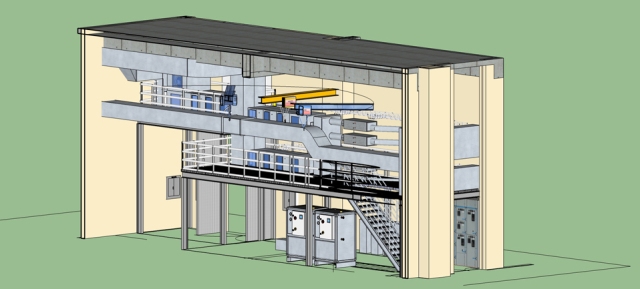Aug 26 2014
The National Institute of Standards and Technology (NIST) is converting one of its laboratories into the equivalent of a small office building—not because of an increase in administrative overhead, but to develop and test smart software technologies designed to slash energy use in commercial buildings.
 Architectural drawing of the new NIST 'intelligent agents' lab for more efficient building control systems. Credit: Kikkeri/NIST
Architectural drawing of the new NIST 'intelligent agents' lab for more efficient building control systems. Credit: Kikkeri/NIST
From schools and hospitals to stores, offices and banks, commercial buildings account for a growing share of U.S. energy use—about 19 percent of the total and a third of electric power consumption.* More than four-fifths of this energy is consumed after construction by heating, cooling, lighting, powering plug-in equipment and other operations. By one estimate, day-to-day energy expenses make up 32 percent of a building’s total cost over its lifetime.**
NIST figures that these energy-eating operations can be accomplished far more efficiently and frugally with existing equipment by more intelligently coordinating their use. At the mock office building now under construction in a standard 1,000 square foot (93 square meters) modular lab space, NIST researchers will put this assertion to the test. There, they and their collaborators will investigate whether artificial intelligence tools already used in search engines, robots, routing and scheduling programs, and other technologies can work cooperatively to optimize building performance—from minimizing energy use to maximizing comfort to ensuring safety and security.
“Adapting intelligent agent technologies from other fields offers the promise of significant improvements in building operations,” explains Amanda Pertzborn, a mechanical engineer working in NIST’s Embedded Intelligence in Buildings Program. “The idea is a kind of ‘one for all approach’—use networked intelligent agents to manage and control devices and equipment subsystems to enhance the overall performance of a building rather than to optimize the operation of each component independently of all the others.”
Intelligent agents are combinations of software and hardware—sensors, mechanical devices and computing technologies—that perceive their environment, make decisions and take actions in response. They can monitor, communicate, collaborate and even learn, predict and adapt.
The energy-saving potential of this smart technology will grow with the evolution of the “smart grid” and its two-way communication capabilities, Pertzborn says. So, for example, cooperating teams of intelligent agents can parse time-of-day pricing, weather forecasts, availability of renewable energy supplies, and occupancy patterns to adjust individual equipment and systems to achieve optimal overall performance.
NIST’s simulated office building will serve as a proving ground for assessing whether intelligent agents dispersed among a structure’s multitudes of devices and subsystems can achieve this unity of purpose and work in concert. Prototypes will be tested on the most energy-intensive of building operations: heating, ventilating and air conditioning (HVAC). So-called HVAC systems in commercial buildings account for about 7 percent of total U.S. energy consumption.***
Modern HVAC systems consist of thousands of devices from local dampers, heaters, thermostats and fans to boilers, air handling units, chillers and cooling towers. When a building’s HVAC system is first installed and tested, this vast assortment of components can be tuned so that the system starts out performing at peak efficiency. Over time, however, efficiency tends to degrade from the optimum and energy use patterns of occupants change, requiring retesting and retuning the system. Intelligent agents distributed throughout a HVAC system would enable continuous tweaking to orchestrate the operation of all components so as to maintain peak performance and efficiency throughout the building’s lifetime.
Using a real building HVAC system under controlled laboratory conditions will enable meaningful comparisons of prototype intelligent agents, Pertzborn explains. Scheduled to be completed in the fall, this building-in-a-lab will consist of four zones serviced by two chillers, three air-handling units, four variable air volume units to control air flow and one ice storage tank, plus pumps, heat exchangers and other equipment.
*U.S. Department of Energy, Buildings Energy Data Book, http://buildingsdatabook.eren.doe.gov/ChapterIntro1.aspx.
**Siemens, Integrated Building Optimization: A Crucial Convergence of Demand-side and Supply-side Energy Management Strategies, 2014.
***J. Shonder, “Fact Sheets on HVAC Measures,” www.pertan.com/ORNL_govenergy/Shonders_HVAC.pdf